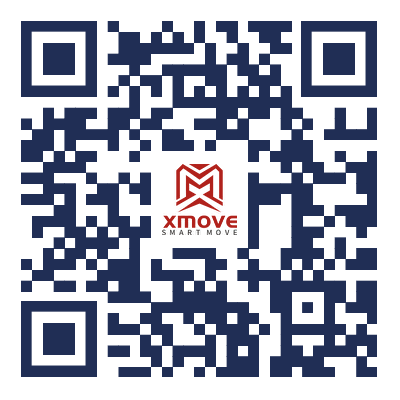Ultimate Guide to Korea Railway
Trains are one of the best means of transportation when traveling between cities in Korea. South Korean trains are divided into three levels according to the speed of the train and the conveniences in the train: the first level is high-speed railway, including KTX and KTX-Shanchuan trains. The second level is electric EMU, including ITX Youth, ITX Xincun and Nuriro. The third level is diesel EMUs, including Infinity Flower, Xincun, diesel-electric commuter trains and sightseeing trains, and the prices are also different. The Gyeongbu Line and the Honam Line are the main hubs of Korean Railways. In addition, there are Jeolla Line and Gyeongjeon Line that connect Yeosu, Changwon and other regions, and Gyeongui Line, Gyeongchun Line, Jungang Line and Donghae Electric Railway that connect various places. line.
Korea Railway KTX
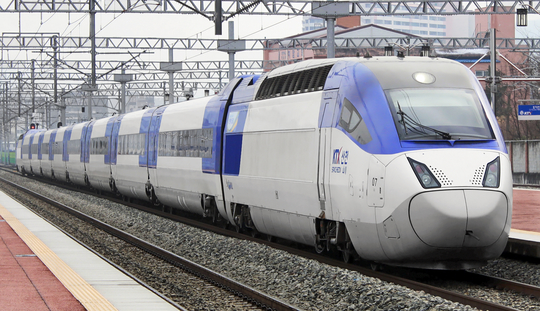
At present, South Korea has launched a KORAIL PASS for foreigners who can take KTX and general trains unlimited times within a specified period. Tourists can enjoy the fun of train travel at a reasonable price.
Train types
South Korean trains are divided into three levels according to the speed of the train and the conveniences in the train: the first level is high-speed railway, including KTX and KTX-Shanchuan trains. The second level is electric EMU, including ITX Youth, ITX Xincun and Nuriro. The third level is diesel EMUs, including Infinity Flower, Xincun, diesel-electric commuter trains and sightseeing trains, and the prices are also different. The Gyeongbu Line and the Honam Line are the main hubs of Korean Railways. In addition, there are Jeolla Line and Gyeongjeon Line that connect Yeosu, Changwon and other regions, and Gyeongui Line, Gyeongchun Line, Jungang Line and Donghae Electric Railway that connect various regions. line.
From the xmove App, you can check the frequency and fare of different types of Korean Railways.
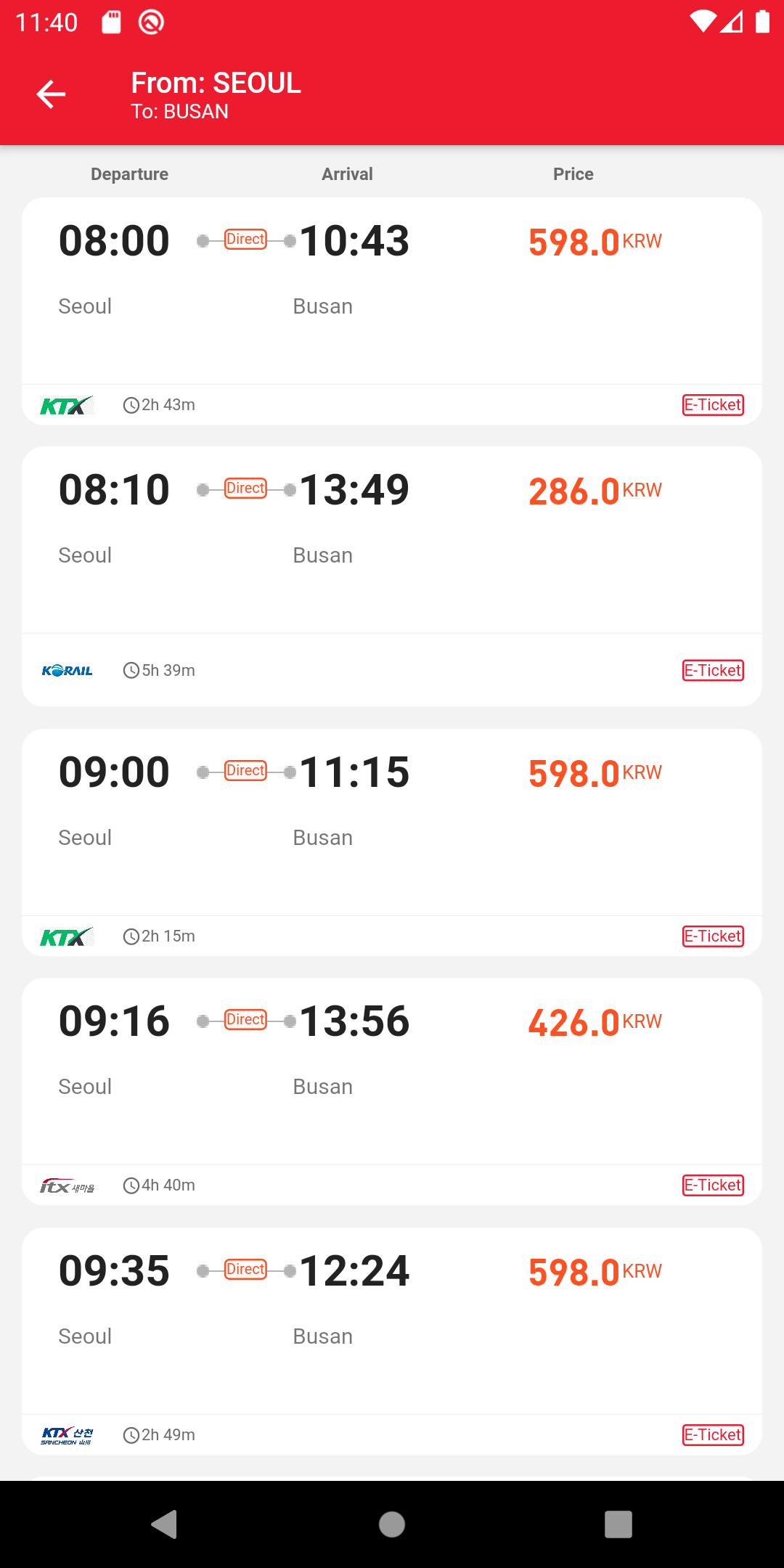
High-speed railway
Each country has a different definition of high-speed railway, and South Korea's high-speed railway can travel at a speed of at least 330 kilometers per hour, and the fastest can reach 305 kilometers. You can enjoy more scenery by taking a high-speed train than by an airplane, and it is faster and more punctual than a car or ordinary train.
KTX
KTX is operated by Korea Railway (Korail) and was built in 1994. After the Asian financial crisis, South Korea's economic development revived, and KTX was quickly built. KTX uses the French TGV-A push-pull high-speed EMU, with a total of 46 units, of which 12 units are manufactured in Alstom, France, and the remaining 34 units are manufactured in Korea. Known as "one of the top ten trains in the world". It was officially opened on April 1, 2004. KTX has 20 carriages, of which two are power units, two are motor vehicles, and sixteen are passenger trains. KTX does not have a dining car to increase passenger capacity.

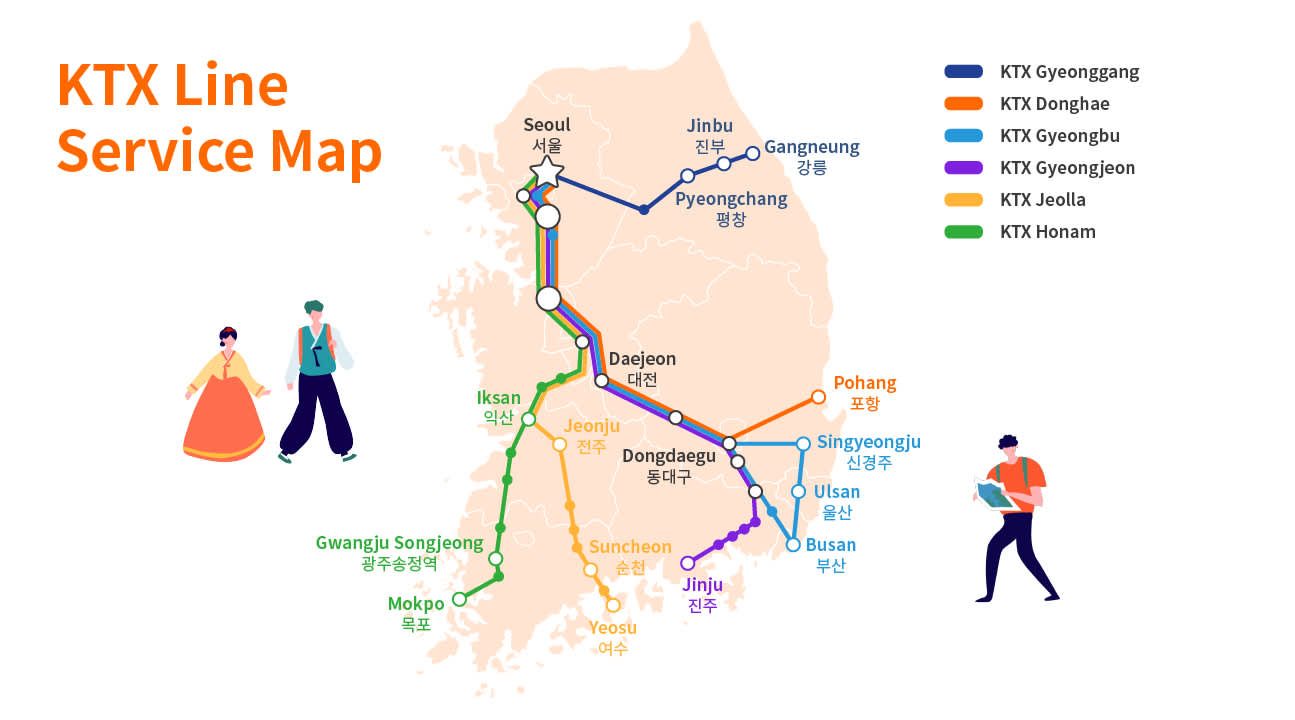
Currently, there are 4 routes for the KTX high-speed train, and the station is different depending on the route, so please confirm carefully.
- At Seoul Railway Station, you can take the Gyeongbu Line that passes through Daejeon, Dongdaegu, Gyeongsan, Miryang and other places to reach Busan Station. Or go through Daejeon, Dongdaegu, Shin Gyeongju, Ulsan and other places to reach the Gyeongbu Line at Busan Station.
*Gyeongjeon line train passing Changwon, Masan and other places to Jinju.
- At Yongsan Railway Station, you can take the Jeolla Line train that passes through Jeonju, Namwon, Suncheon and other places and connects to Yeosu Station.
- From Yongsan Railway Station, you can take the Honam Line that goes to Mokpo via West Daejeon, Iksan, Gwangju and other places.
Class
KTX has three types of seats: first-class, standard and free seats. There are 127 seats in the first class, with three seats in each row. The adult fare is about 77,700 won/one-way ticket, and the child ticket is about 49,900 won/one-way ticket. There are 808 seats in the economy class, with four seats in each row. The ticket for adults is about 55,500 won/one-way ticket, and the fare for children is about 27,700 won/one-way ticket. A non-reserved seat adult ticket costs approximately 27,700 won/one-way ticket, and a child fare is approximately 23,600 won/one-way ticket. The first class seat can rotate, but the standard seat is fixed.
KTX High Speed Rail First Class
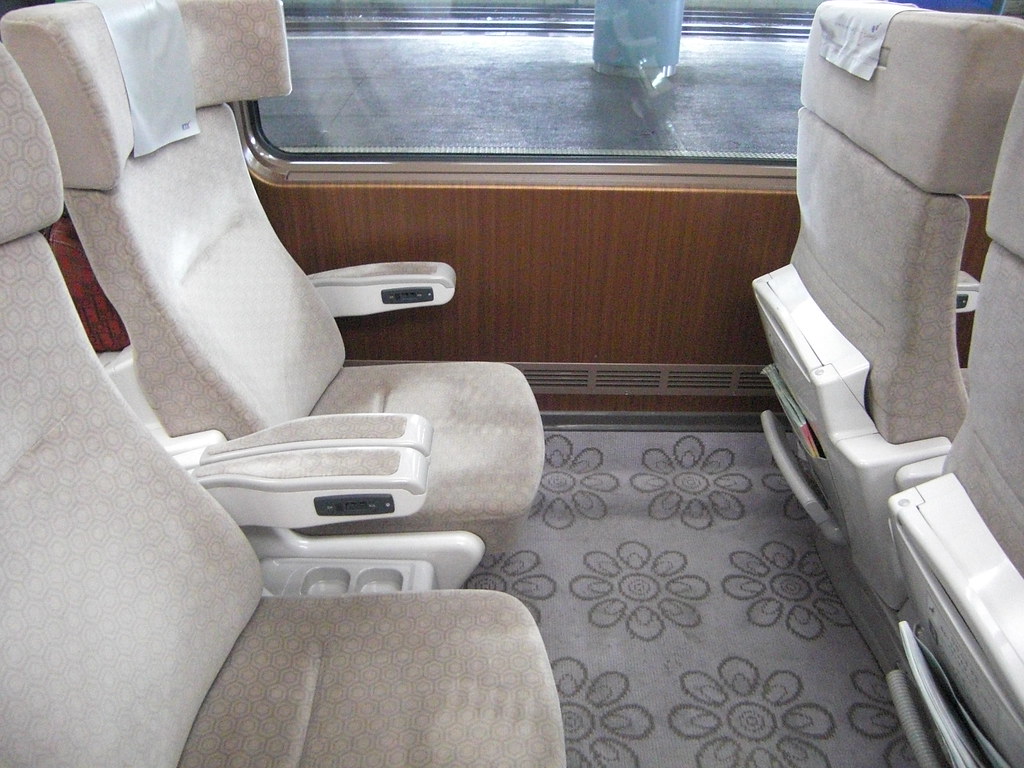
The second generation of KTX high-speed train-KTX Shanchuan
The KTX Yamakawa, which started operation on March 2, 2010, was formerly known as KTX-II, and was the first high-speed train in South Korea to be manufactured entirely using domestic R&D technology. It not only eliminates the disadvantages of narrow seats and inability to adjust direction in ordinary carriages of the first-generation KTX high-speed trains, but also improves service specifications and adds business seats and fast food bars. The KTX Shanchuan was put into operation on the Gyeongbu Line and Hunan Line on March 2, 2010.
The KTX Shanchuan has ten cars, of which two are power cars and eight are passenger trains. The seats are divided into first-class and standard seats. The first-class seats have thirty seats, with every three seats in a row. The standard seat has 333 seats, and each row has four seats. All seats can be rotated.
Electric EMU
ITX Youth
ITX-Youth Train
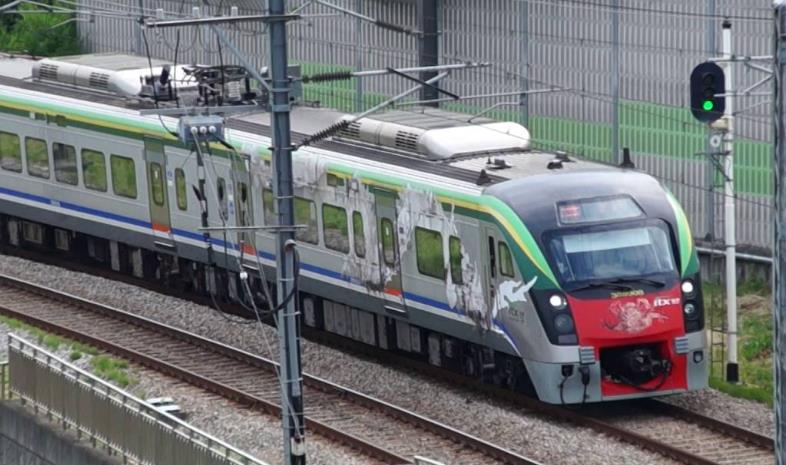
ITX-Young (Korean: ITX-청춘) is one of the electric trains of the Korea Railway Corporation. It started operating on the Metropolitan Electric Railway Central Line and Gyeongchun Line on February 28, 2012, and then on May 1, 2017. Started operations on the Gyeongbu Line. After the electrification of the Gyeongchun Line in 2010, the Korea Railway Corporation plans to replace the Infinity Flower and Nuriro on the Gyeongchun Line with new trains. Finally, after the train left the factory on September 25, 2011, it was decided to be named ITX-Youth. The ITX Gyeongchun Line runs between Yongsan Station and Chuncheon Station and is an express train. Passengers can board the train at Yongsan Station, Oksu Station, Wangshili Station and Cheongnyangni Station in Seoul. The stop station will vary according to the date and time zone, and all ITX Youth Trains stop at Yongsan Station, Cheongnyangni Station, Gapyeong Station, Namchuncheon Station and Chuncheon Station. Starting in 2017, the ITX Youth Train on the Gyeongbu Line from Yongsan Station in Seoul to Daejeon Station was officially opened. You can take trains at Yongsan Station, Noryangjin Station, and Sindorim Station in Seoul, and you can easily transfer to subway lines 1, 2, and 9. Although there is no difference between the stops, the train schedule may be different on different days, so be careful when you ride. The ticket is divided into general seat ticket and station ticket.
ITX New Village
The introduction of ITX-Saemaul (ITX-Saemaul) aims to replace all the old Xincun trains by 2018. It began to run on major Korean railway lines such as the Gyeongbu Line, the Honam Line, and the Jeolla Line on May 12, 2014. The maximum speed of the train is 150 kilometers per hour. After the announcement of the train, a naming vote was held, and the old name "Sincun" was elected after the new village movement led by President Park Zhengxi. The stations passed by the Xincun number are as follows:
- Gyeongbu Line Shinjuku Busan
- Tokai Line Shinjuku Shinkai Unkai (direct to Gyeongbu Line)
- Gyeongju Line Sugi Jinju (direct to Gyeongbu Line)
- Konan Line Yongsan Mokpo (direct to Gyeongbu Line)
- Shonan Line Yongsan-Gwangju (direct to Gyeongbu Line and Gwangju Line)
- Jeolla Line Yongsan Yeosu Exhibition Hall (directly connected to Gyeongbu Line and Hunan Line)
- Central Line Chiang Saen Rongju
ITX-Xincun has only standard seats and no first-class seats
Nuriro number
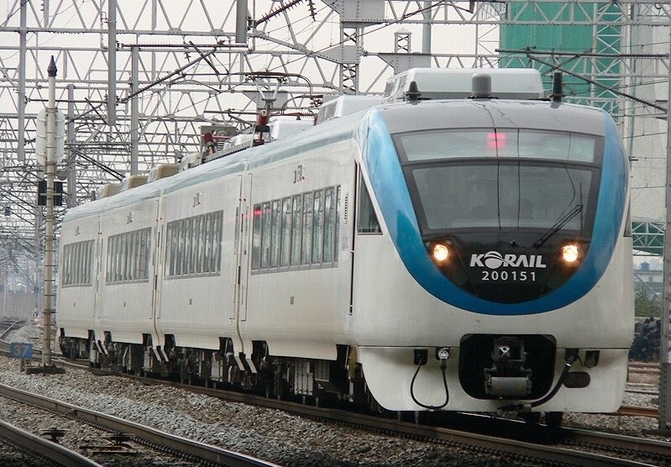
The Nuriro, or Nooriro (Korean: 누리로) is one of the quasi-high-speed railway trains of the Korea Railway Corporation. It started operating on the Gyeongbu Line and Changhang Line on June 1, 2009, and on March 31, 2010. Operation of Chungbuk Line. After the electrification of the Changhang Line on December 15, 2008, the southernmost terminus of Metro Line 1 of the Capital Circle extended to Xinchang Station. The Korea Railway Corporation began to replace the Infinity Flower train with Nuriro trains in the Seoul-Shinchang section of Metro Line 1 on June 1, 2009. On March 31, 2010, the Seoul-Jecheon section was opened again, and the original Mujeonghwa train replaced the Sinchon route in 2015. In addition, before ITX-Youth appeared, the Nuririo train also ran on the Jingchun Line from December 25, 2010 to February 28, 2012. Trains currently operate on the following railway lines:
- Gyeongbu Line, Changhang Line: Seoul to Xinchang
- Gyeongbu Line, Chungbuk Line: Seoul to Jecheon
- Gyeongbu Line, Chungbuk Line: Daejeon to Jecheon
- Gyeongbu Line, Honam Line, Gwangju Line: Yongsan to Gwangju
Diesel EMU
New Village
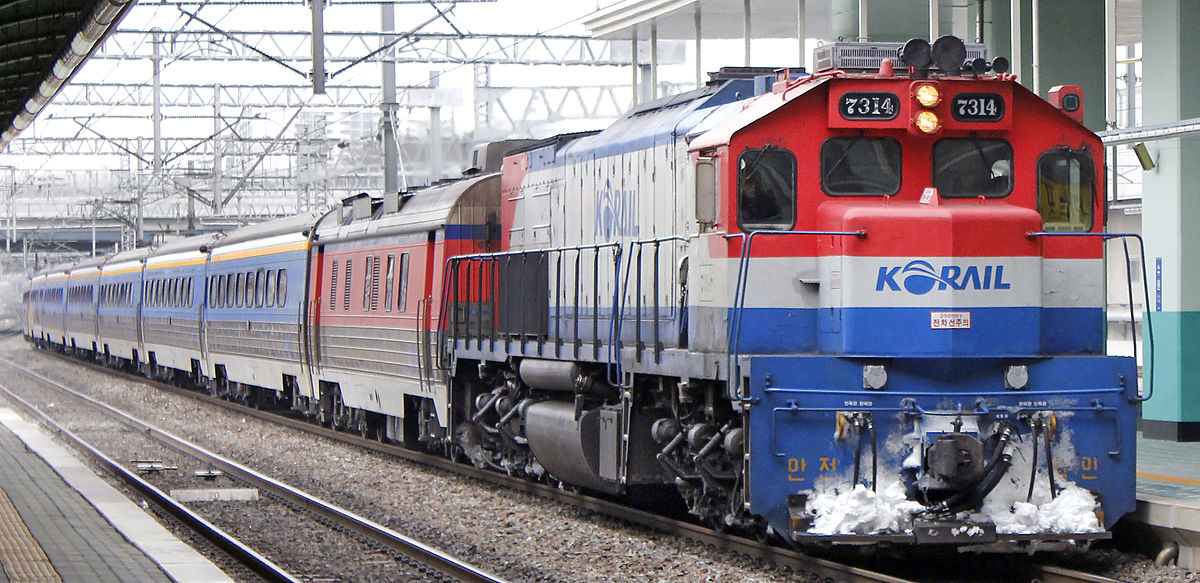
The Sinchon (새마을호, Saemaul ho) was Korea’s most advanced railway passenger car before the high-speed railway opened to traffic. The Xincun number generally consists of 5-12 carriages. Compared with the next-level Infinity Flower, Xincun is more spacious and has no station. In terms of color, the new village number is mainly green, white and yellow. On the other hand, the Sinchon line is concentrated on the main line. For example, when traveling between Seoul and Busan, the Gyeongbu Line will be used instead of the Joongang Line (since November 2006).
Current operating interval (since December 5, 2012)
- Gyeongbu Line: Seoul-Busan, Seoul-Dongdaegu, Busan→Yongsan
- Gyeongbu Line, Gyeongsangbuk Line: Seoul-Jinju
- Gyeongbu Line, Daegu Line, Jungang Line, Donghae Southern Line: Seoul-Pohang
- Gyeongbu Line, Janghang Line: Yongsan-Iksan (101 series stop at Janghang, Gunsan)
- Gyeongbu Line, Honam Line, Gwangju Line: Yongsan-Mokpo, Yongsan-Gwangju
- Gyeongbu Line, Honam Line, Jeolla Line: Yongsan-Yeosu EXPO
- Chuo Line: Cheongnyangni-Andong
- Sea Train: Samcheok-Gangneung
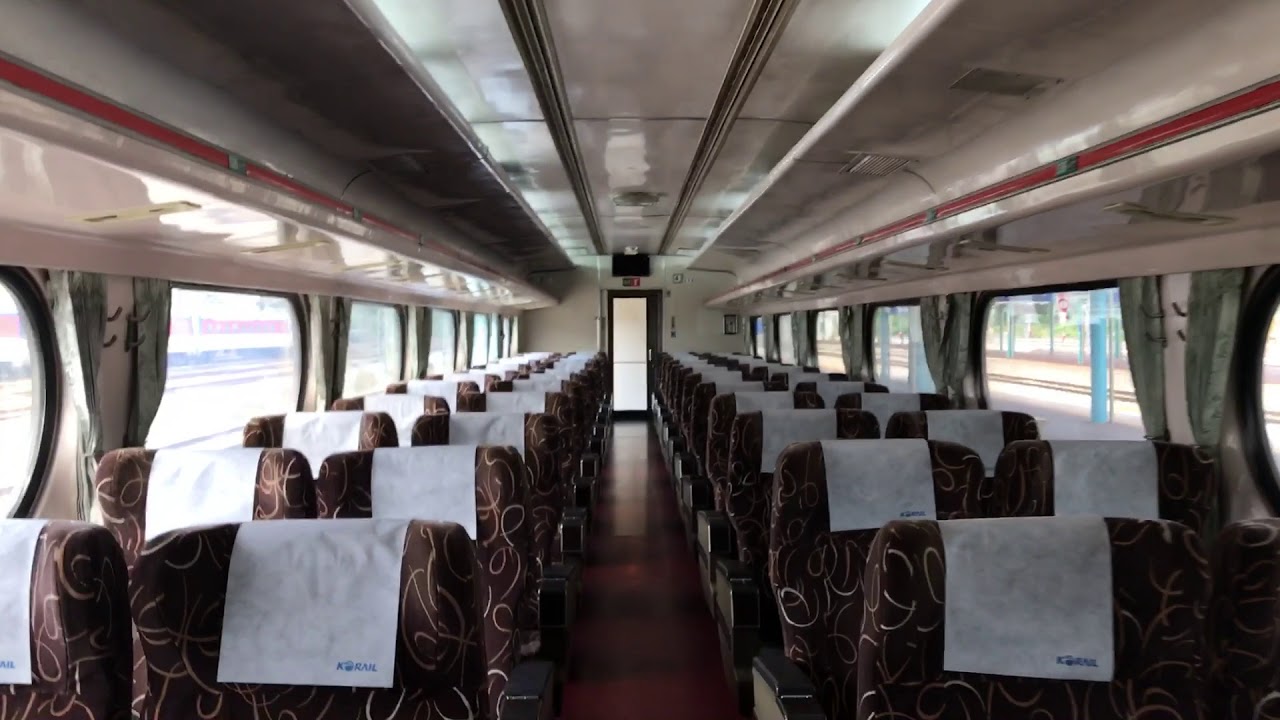
The cabins of Xincun are divided into first class and standard. The first class has wide seats, light adjustment equipment, personal reading lights, rotatable and adjustable seats, feet, back folders and tables. The train can carry 376 people, and all trains have double general seats. There are also service facilities such as vending machines, LCD monitors, maternity rooms, electric tea stoves, and free Wi-Fi service in the train. Each train has a coffee cabin, which has a canteen and leisure facilities such as computers, game consoles, karaoke rooms and massage chairs.
Infinite Flower
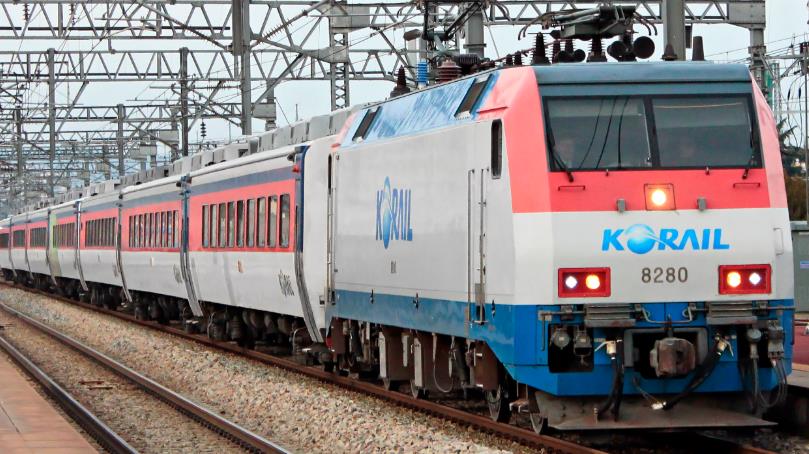
The Mugunghwa ho (무궁화호/Mugunghwa ho) is the lowest-priced passenger train type in the Korean National Railways network. It is now generally operated on the main railway sections and some branch railways in Korea that have not been electrified. The train began to run on the Gyeongbu Line and the Gyeongsang Province on April 15, 2008. It now runs on most of the routes in southern Korea. The operation of Infinity Flower began on January 1, 1984. Before South Korea's high-speed rail opened in 2004, the Infinity Flower was the most common passenger car in the area. On rural routes such as the Gyeongbuk Line, the Mujonghwa is the only train used, and it stops at every station.
Unlike the high-speed train and the Xincun, the Infinite Flower can accommodate more passengers and has more stations. There are light adjusters, personal reading lights, automatic doors, adjustable and rotating seats and toilets in the train. Each train has a coffee cabin, which has a canteen and leisure facilities such as computers, game consoles, karaoke rooms and massage chairs. Infinity Flower is named after Korea's national flower-Infinity Flower (Hibiscus)
Train Types
Ticket
Korail Pass
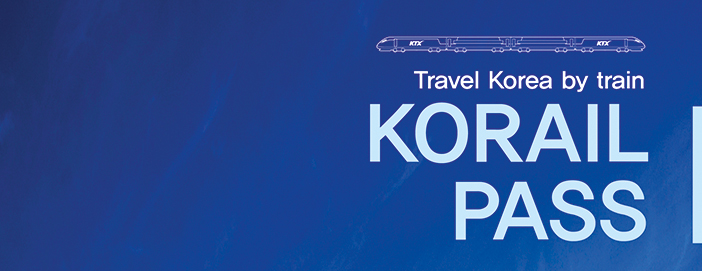
General trains (KTX, KTX-Mountain, ITX-Sinchon, Sinchon, Infinity Flower, Nuriro, commuter train, ITX-Youth train) and 5 types of sightseeing trains (Central Inland Loop Train O-train), Jeongseon Arirang train (A-train), Namdo marine train (S-train), canyon train (V-train), peace train (DMZ-train), etc.
Train
General trains (KTX, KTX-Mountain, ITX-Sinchon, Sinchon, Infinity Flower, Nuriro, commuter train, ITX-Youth train) and 5 types of sightseeing trains (Central Inland Loop Train O-train), Jeongseon Arirang train (A-train), Namdo marine train (S-train), canyon train (V-train), peace train (DMZ-train), etc.
Ticket type
A self-selected ticket is a ticket that can be used for three or five consecutive days from the initial boarding date, and a continuous ticket is a ticket that can be used for two or four days within ten days from the initial boarding date. Child tickets are only applicable to children between the ages of 6 and 12, and adult tickets are required for 13 years and above. Passengers paying adult fare can each bring one child under six years old.
Optional two-day ticket
Adult: 121000₩
Child: 61000₩
Economy (with 2-5 people): 111,000 ₩
Three consecutive days ticket
Adult: 138000₩
Child: 69000 ₩
Economy (with 2-5 people): 128,000
Optional four-day ticket
Adult: 193000₩
Child: 97,000 ₩
Economy (with 2-5 people): 183,000 ₩
Five consecutive days ticket
Adult: 210000₩
Child: 105000₩
Economy (with 2-5 people): 200,000 ₩
*Not applicable to subways and sightseeing trains.
How to buy
When purchasing a ticket, the customer must enter the personal information consistent with the passport. KORAIL PASS is for personal use only, and the passenger's information must be entered. After the customer pays and the ticket is issued, the passenger's personal information and PASS information Not changeable.
Tickets can be purchased at the following places of purchase; G2Rail website, designated travel agencies and KORAIL Visitor Center
Korail visitor centers are available in Seoul, Yongsan, Suwon, Yeongdeungpo, Cheongnyangni, Masan, Busan, Ulsan, Dongdaegu, Gwangju Songjeong, Mokpo, Yeosu Expo, Suncheon, Iksan, Daejeon, Cheonan Asan, Jecheon, Found at Yongzhou and Pyeongchang Station.
KORAIL Pass User Guide
Designated seats: One person can purchase two tickets for designated seats per day. Passengers can only book travel dates and train numbers within the validity period of the PASS. Tickets are open for booking from one month before the train departure date. Due to the implementation of separate management during the peak period of Korean holiday passenger transportation, the pre-sale will be opened from the designated date on the other route. If seats are sold out, passengers will not be able to reserve seats. If this happens, please bring a valid KORAIL PASS and passport to use a standing seat (standing). After using the designated seat opportunity (more than two rides in the car), please bring a valid RAIL PASS and passport to ride the seat. Tickets cannot be booked repeatedly within the section that cannot be reached within the same day. Therefore, useless seat tickets should be cancelled in the "Usage History" menu or at the station window.
Use time of optional 2-day ticket and optional 4-day ticket: The optional ticket must first specify the travel date before you can reserve seats on the same day.
Precautions
- Tickets are for personal use only, and cannot be resold or transferred to others for use. If a passenger is found to have used a ticket improperly, he must pay a penalty of 10 times the freight rate and a maximum of 30 times the fare for the travel section.
- You must have a printed copy of the official KORAIL PASS, a train ticket and a valid passport when you board the train, and present documents as required by the station staff and flight attendants.
- At peak periods such as National Day, holidays (Spring Festival, Mid-Autumn Festival), and summer vacation, when seats are sold out, standing seats can be used after holding a valid KORAIL PASS and passport.
- A valid passport and credit card are required to purchase KORAIL PASS.
- Optional tickets (two-day and four-day tickets) are valid for ten days from the initial boarding date, and you can choose to travel for two or four days within the specified ten days. If you take a seat, you need to find the conductor to endorse the date of use.
- When the train is delayed or cancelled, there is no corresponding compensation.
Point to point ticket
From the xmove App, you can directly inquire about the timetable and price of various trains of Korea Railway, or you can directly place an order to buy a ticket. Korean Railway train tickets are electronic tickets.
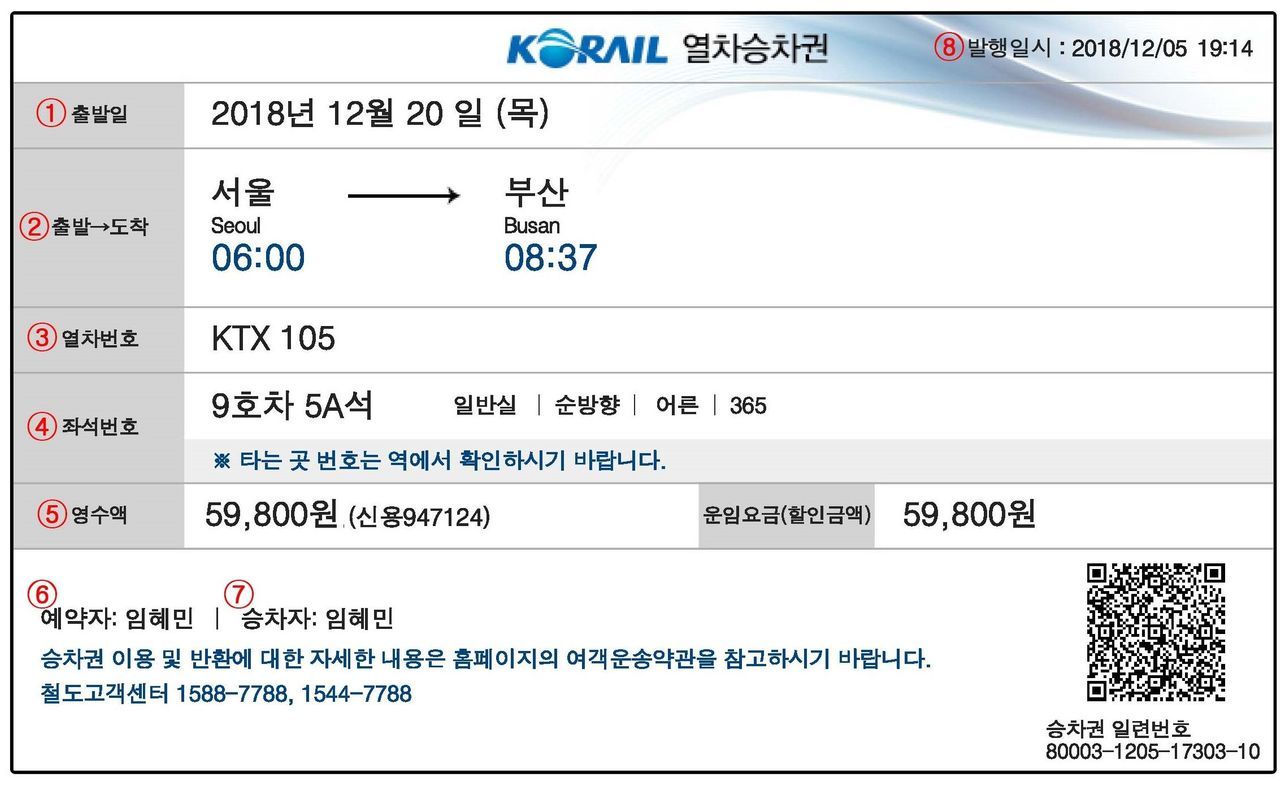
Price discount
The discount method of Korean railway ticket prices is different from other railway companies. The KTX train is 40% more expensive than the Saemaul train (while the KTX 1st train is 40% more expensive). Saemaul First Class fares are 22% higher than standard Saemaul fares. The standard fare of Saemaul is 50% higher than the Mugunghwa grade. If you buy KTX tickets 7 to 30 days before departure, you can enjoy a discount of 7% to 20%. From Monday to Friday, tickets can enjoy a 15% discount; and ipseokpyo (stand-up tickets) can be discounted 15% to 30% according to the length of the journey. With a standing ticket, you can sit on any unused seat. Children can travel at half price at any time; seniors over 65 can enjoy a 30% discount from Monday to Friday.
Reservation
Passengers can purchase tickets one month in advance. It is recommended to book a seat on weekends, holidays or busy times.


